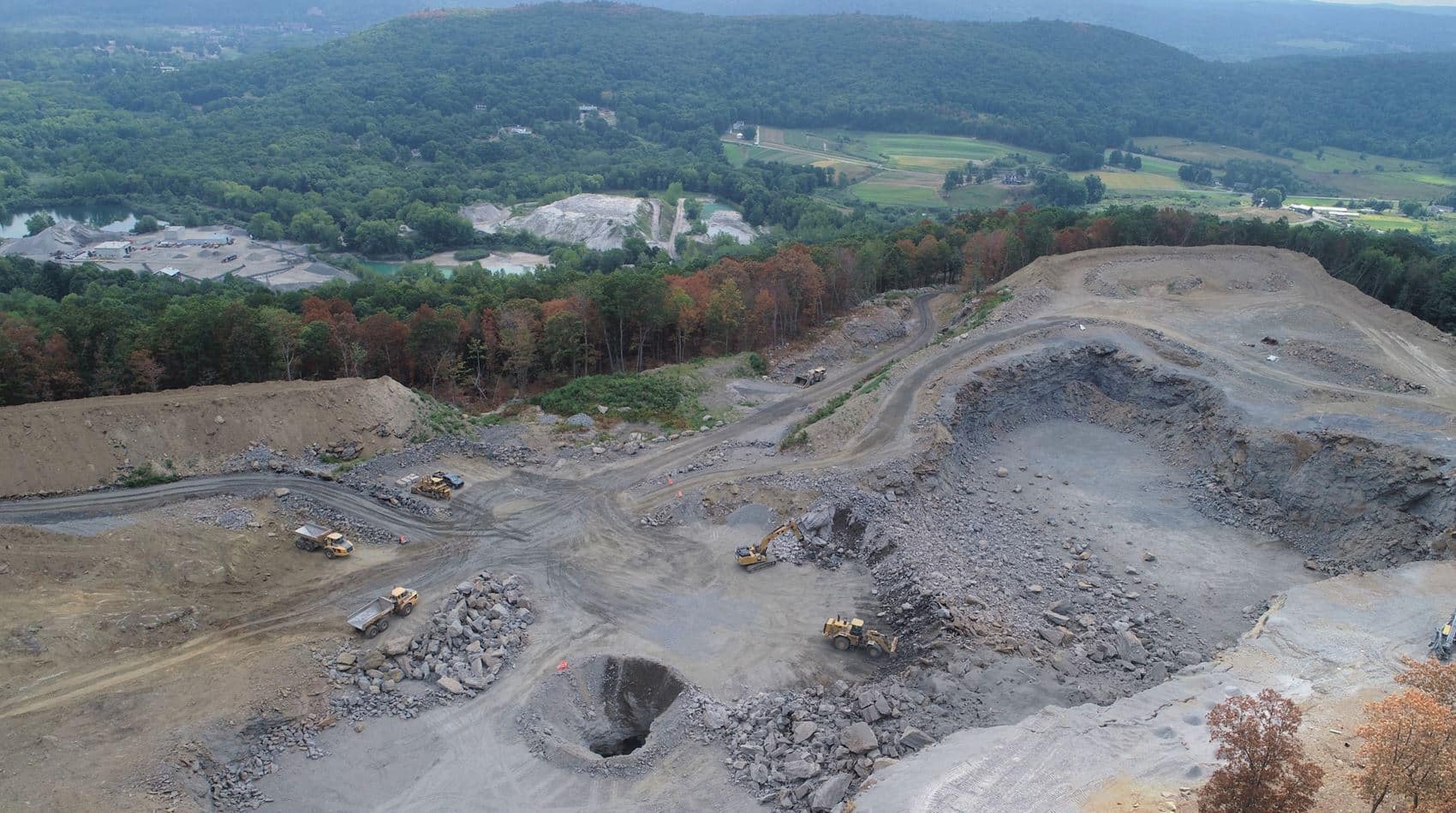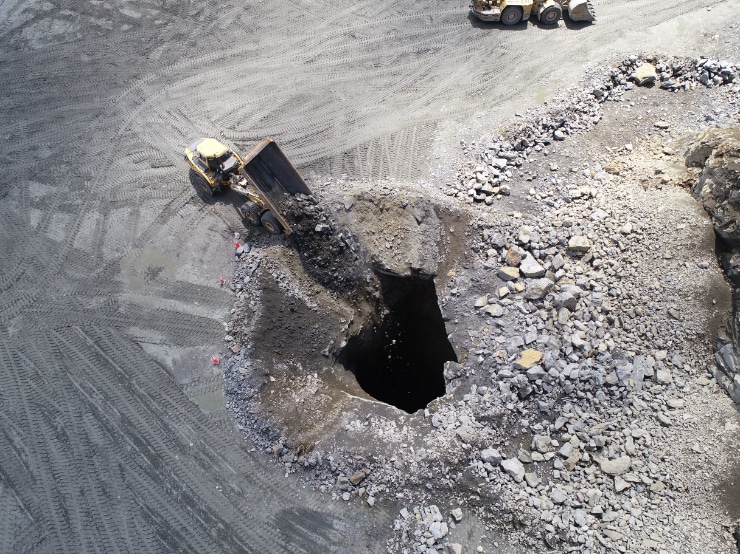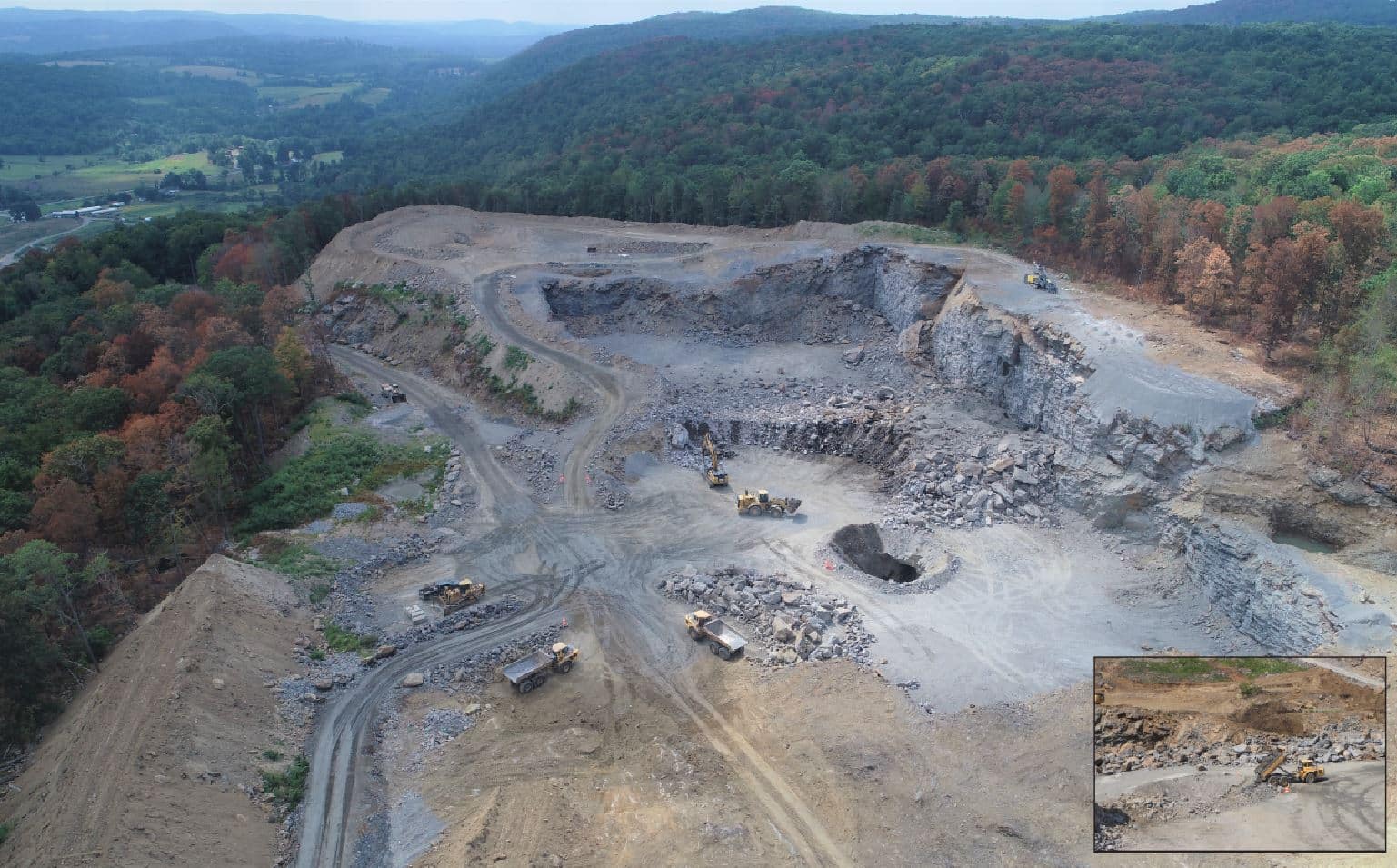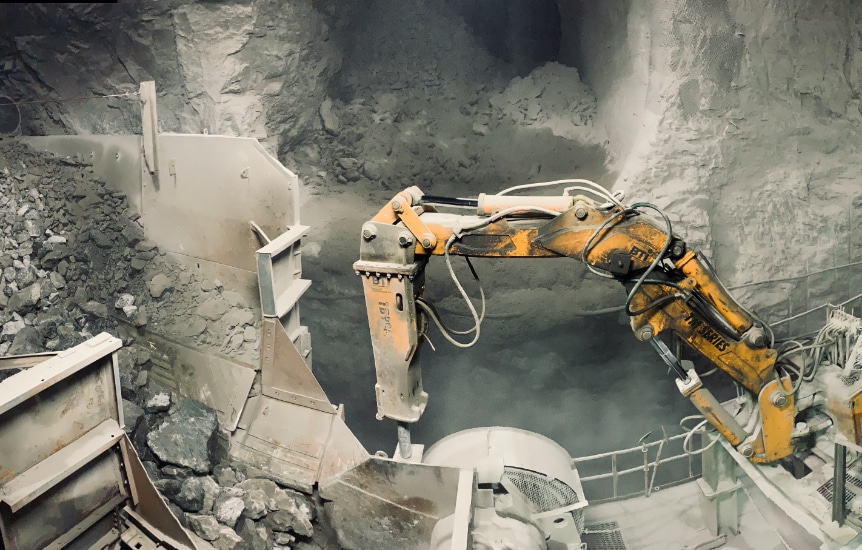Peckham Quarries the Surface, Crushes Underground
BY AsphaltPro Staff

Peckham Industries, Brewster, New York, has been operating its quarry in Wingdale, New York, for 27 of the company’s 99 years in business. According to Peckham Director of Technical Services Jason Kappel, the quarry is not only an important operation for the company but also for the regional economy.
“[Our Wingdale quarry] is one of the only sources of non-carbon, high-friction aggregates on the east side of the Hudson River,” Kappel said. The Wingdale quarry supplies Peckham’s five hot-mix asphalt plants serving the New York City suburbs and Westchester County.
In 1994-95, the quarry underwent a significant change when its operations went underground. Doing so not only resulted in improved material quality, but also helped mitigate issues with limited water supply during some parts of the year, as the former surface quarry could be used as a reservoir for process water to support underground operations.
“Many underground facilities have stopes, but the connection to the surface and that the stope is 230 feet deep made this quite a project.”—Kevin DeSilva
However, Kappel said, the primary reasons for moving quarrying operations underground were to minimize environmental concerns, mitigate potential complaints from the community, and expedite the permitting process.
Over the next two decades, Peckham developed two of the four 188-acre levels it was permitted for, converted from flat roofs to arched roofs, and developed a series of stopes to allow for material transfer from level two to level one.
“In 2006, we brought the primary and secondary crushers underground, which was a key development [for our later plans], though we didn’t know it at the time,” Kappel said. “We’re always looking to reduce the cost of production at this facility, and continuing to crush underground is a very efficient process for us and enables us to eliminate trucking and other development costs.”
But, as Peckham’s underground blasting moved south of a fault line running through the facility, the company began to receive complaints from neighbors. “When we were on the other side of the fault, we’d have people feeling it from 1.7 miles away,” Kappel said. “I sat at a residential property 1.7 miles away on a concrete front stoop to feel what people were feeling and it was really unbelievable. It just happens to be the way the faults are in our area.”
That’s when the company decided to move its quarrying operations back to the surface. Peckham hired both Kappel and Kevin DeSilva as consultants to help them do so, and later, hired them both full-time.
In addition to moving the quarry operations to the surface, DeSilva and Kappel brought an innovative solution to the table. “We thought, ‘If we can stope between level one and level two, why can’t we stope from the surface down?’” Kappel said. The company created a 230-foot stope, into which it feeds aggregate from the surface to its primary and secondary crushers underground and then conveys it back to the existing surface processing plant.
“To our knowledge, this is the only stope of its kind in the country,” DeSilva said. “Many underground facilities have stopes, but the connection to the surface and that the stope is 230 feet deep made this quite a project.”
In the fall of 2022, the National Institute for Occupational Safety and Health (NIOSH) Mining Program, in conjunction with the Essential Minerals Association, the National Mining Association, and the National Stone, Sand and Gravel Association, recognized Peckham Industries with a NIOSH Mine Safety and Health Technology Innovations Award in the stone, sand, and gravel category for its implementation of the stope. “It is a benefit to the entire mining industry to have such innovative approaches tackle both new and persistent challenges,” said NIOSH Associate Director for Mining Jessica Kogel, Ph.D.

Peckham feeds aggregate from the surface down a stope 230 feet deep. The material is crushed underground and then conveyed back to the existing surface processing plant.
Big Benefits
Ultimately, the new process is estimated to save the company significant production cost and offers a number of benefits. Among them, a significant increase in tonnage, up to 70,000 tons a day from as low as 1,100 tons a day during underground quarrying (since much of the material had to remain underground for safety reasons).
As a result of the increased efficiency, the crew works shorter hours and has a better employee work/life balance. Furthermore, Peckham has been able to reduce the underground crew size from 12 to four, improving both safety and morale. There are also fewer ground control and stability issues to manage as a result of the smaller underground operation.
“Moving the quarrying above ground helped get more employees out from underground, which is a challenging situation with more risks compared to the surface,” said Steve Benton, corporate safety director for Peckham. Crushing the materials below ground is also for improved safety, he said. “It’s been good from a community relations standpoint. We’ve been able to reduce the burden on our neighbors to the point that they don’t even know we’re there. It’s made our operations quieter and less dusty.”
According to DeSilva, now Peckham’s Environmental Compliance Manager, the quarry hasn’t received any complaints since its return to the surface with continuation of underground crushing. Ultimately, the company has been able to eliminate community concerns over noise and dust, improving its relationship with nearby residents.
“We’ve been able to reduce the burden on our neighbors to the point that they don’t even know we’re there.”—Steve Benton
These changes also made it possible for Peckham to eliminate six pieces of equipment, resulting in less fuel use and reduced emissions. This included two double boom horizontal JH Fletcher drills, two Cat 2900 load haul dump rubber tire loaders, one Cat 980 rubber tire loader and one Ackerman rubber tire excavator. Now, the only equipment underground are the primary and secondary crushers and a frontend loader used to feed the primary.
These changes have also resulted in improved air quality underground and reduced electrical consumption due to reduced ventilation fan use. “We were able to reduce the footprint of our underground mine and really focus our ventilation efforts around our processing area here,” DeSilva said.

By delivering rock mined in the surface quarry to be crushed underground via the stope, Peckham has eliminated long haul distances on steep grades, left a scenic ridge untouched, and realized efficiencies in equipment, fuel and time, among other benefits.
Overcome Obstacles
Despite its many benefits, these changes were not without their challenges. The creation of the stope to the surface changed the pressure underground and the company began to see freezing occur underground that it had not previously seen.
“We knew the ventilation was going to change, but it was hard to predict how it would change,” DeSilva said. Peckham hired Appalachian Mining & Engineering, Inc. to perform a ventilation study with the stope completely open, which resulted in changing the orientation of the fans and placing curtains to isolate the crushing areas. Once aggregate reached the collar of the stope, Peckham performed a second ventilation study that showed when the stope is full of stone, ventilation conditions return to pre-stope conditions.
“With those two ventilation studies, we have bookends from which we can optimize ventilation,” DeSilva said, which includes fan orientation and direction of flow as well as placement of brattice cloth to help direct clean air to work areas. “We also try to balance what we draw from the bottom with what we feed from the top, because it helps with ventilation challenges.”
Satisfy DEC
When Peckham began investigating how best to return its quarry to the surface, it had considered locating the processing area west of the current location and making a key cut through a ridge that runs across the property. Ultimately, the company decided to maintain the ridge and instead improve its whole haul road to get its equipment up to the surface quarry.
“We were able to eliminate any concerns from the community by hiding our operations behind the ridge,” DeSilva said, adding that the preservation of the ridge also reduced noise.
Despite the gains in efficiency, improvements to employee safety and wellbeing, and the preservation of the ridge, it still took the state of New York almost five years to permit Peckham’s surface quarry.
One of the DEC’s concerns was the forest habitat near the quarry, which it claimed to be a habitat for bats. However, U.S. Fish and Wildlife agreed with Peckham’s biologists that the company’s presence wouldn’t impact the bat habitat as bats don’t live above an elevation of 1,000 feet and the lowest elevation in question is 930 feet. “But, the DEC had an analyst who didn’t agree,” DeSilva said.

By moving its quarrying operations to the surface and maintaining just crushing operations below ground, Peckham has been able to reduce the underground crew size from 12 to four, improving both safety and morale.
Ultimately, Peckham converted a piece of land elsewhere on the property at a lower elevation into an ideal bat habitat. The company also worked with the Army Corp of Engineers to develop a three-acre wetland to mitigate the loss of one acre of wetland for the quarry. “That alone was almost a million-dollar project,” DeSilva said.
“Most of the property remains wooded, and we’ve committed to only clear five acres of trees annually to maintain that forested area,” DeSilva said. “The development of the property in a very slow, methodical manner helped mitigate their concerns about habitat loss.”
Peckham also agreed to reclaim the majority of the surface quarry as a lake (±85.5 acres) and above water table benches as forest (±26.7 acres).
“We were very thoughtful [with this solution],” DeSilva said. “I’m not saying it’s a model everyone can use, but it certainly solved a lot of our problems. We’re very proud of it.”
